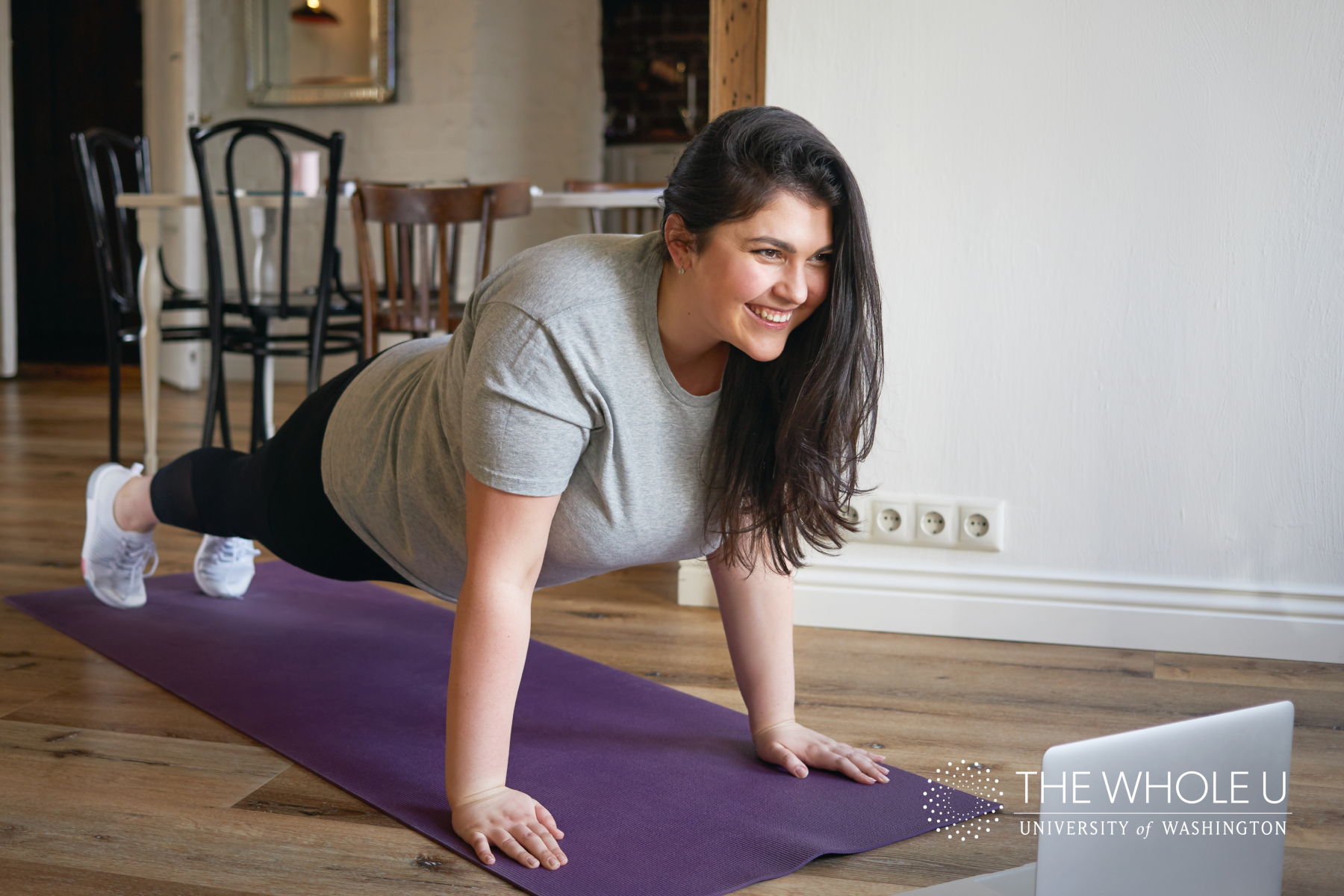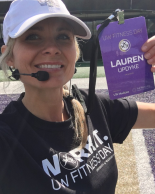
Exercise Motivation with The Whole U
Sometimes it’s easy to get caught up in the big, hard-to-attain goals: capital-R resolutions or the latest trendy (and often expensive) way to move. We start something so intense that we can’t finish or fit it into our schedules.
Despite what you may see or hear from the fitness industry or on social media, there is no one best way to exercise, and just because something is new and shiny doesn’t mean it’s the right choice for you. There are thousands of ways to move your body, and it’s up to you to determine what type and amount works for your body, your lifestyle and your goals.
In this article we will dive into four main topics: tips for being active, common questions around being active, professional recommendations about being active and sample workouts to start giving you ideas.
Tip for being active
1. Try hard not to compare your physical activity to previous stages of your life. Start fresh wherever that may be. It can be humbling at times but trust me, only you think this way. You got this!
2. Identify activities you enjoy: what kinds of movement do you love? Yoga, dancing, walking, golf, tennis, swimming, Tai Chi? Start with those!
3. Think about activities that you know would benefit your health, but that you have a hard time fitting in to your schedule. The best workout sometimes can be the one we didn’t want to do. We can do hard things!
4. Write down some activities you already do daily. Identify one activity that you could combine with a new movement habit.
For example:
- Do 25 calf raises while you brush your teeth in the morning.
- Practice a challenging yoga pose while your coffee brews.
- Jog or march in place while your food is cooking in the oven.
- Walk 10 minutes after your first cup of coffee.
Common questions around physical activity
1. How do I stay consistent?
Staying consistent is the hardest part of incorporating movement into your daily life. Ideas that might help include:
- Write down a plan or seek a plan to help you with your exercise goals.
- Set a SMART goal. Try this template to help guide you.
- Add your exercise to your schedule/calendar just like you would a meeting or other commitments.
- Try exercising in small amounts of time first then slowly build onto that time.
- Try not to beat yourself up when you fall off track or have a setback. It happens and will happen a lot.
- Grab a friend or exercise buddy to keep each other accountable.
Staying consistent is a process and matters more when you get back into the routine after a setback.
2. How do I get started when I don’t know where to start?
I recommend starting with the activities that you enjoy and designing your plan in small increments. For most adults, the recommendation is to balance cardio, strength, and flexibility each week, beginning with the type of movement you will realistically fit in most.
3. How do I not beat myself up for not being able to do certain things or activities anymore?
Over time, the ability of our bodies to train, repair and recover will change and what we were once able to do may no longer be an option. We may lose strength, speed or agility, and it can be hard on our self-confidence and leave us feeling unmotivated. For me, an important antidote to this feeling is to not compare myself to myself from years past. Practicing self-compassion and adjusting my goals and my mindset really helps.
Trying new activities or opportunities is also a great way to amplify your motivation. Novelty in movement is important for brain fitness too, so varying exercise types, mixing up your workouts, and challenging yourself to learn a new activity can help keep the mind sharp and your heart pumping. Finally, starting from scratch and building towards a fresh, attainable goal—even in an activity that you have previously practiced—can help reset your intentions and give you a fresh perspective.
Sometimes when I exercise, instead of judging my intensity by pace or workload I judge by my effort—instead of focusing on the numbers on my watch I just enjoy the movement and the moment. And remember, all exercise supports a healthy body and a healthy brain!
What should I consider when plateaus hit during my exercise journey?
Plateaus are going to happen. I view these as pauses or opportunities to change things up. Try your best to view these in a positive way.
Standard recommendations for exercise
The U.S. Department of Health and Human Services published their second edition of the Physical Activity Guidelines for Americans. This comprehensive publication offers guidelines for children, adolescents, adults (including women during pregnancy and the postpartum period, as well as adults with chronic health conditions and adults with disabilities), and older adults.
UW Recreation summarized the guidelines for us here:
1. Move more, sit less.
Some physical activity is better than none and some health benefits can be attained by doing any amount of moderate-to-vigorous physical activity.
2. For significant health benefits, adults should do at least:
- 150-300* minutes a week of moderate-intensity aerobic activity, OR
- 75-150 minutes a week of vigorous-intensity aerobic activity, OR
- An equivalent combination of moderate- and vigorous-intensity aerobic activity per week.
- Ideally, aerobic activity is spread throughout the week.
*Note: additional health benefits are gained by engaging in physical activity beyond the equivalent of 300 minutes of moderate-intensity physical activity a week.
3. Muscle-strengthening activities can provide additional health benefits.
- Target all major muscle groups on 2 or more days per week.
- Perform muscle-strengthening activities of moderate or greater intensity.
So there you have it—in a given week, at a minimum, you should be striving for 150 minutes of moderate-intensity aerobic activity and 2 days of muscle-strengthening activities. Now that you know the basic formula, you can start to write your own personal fitness plan.
Consider these forms of movement
In a week, you could do:
- 30 minutes of moderate-intensity aerobic activity on 5 days and do muscle-strengthening activities the other two days.
- 50 minutes of moderate-intensity aerobic activity on 3 days, muscle-strengthening activities on 2 days, and rest the other 2 days.
- 25 minutes of vigorous-intensity aerobic activity on 3 days, muscle-strengthening activities on 2 days, and rest the other 2 days.
Examples of moderate-intensity physical activity include:
- Brisk walking
- Recreational swimming
- Bicycling slower than 10 miles per hour on level terrain
- Group fitness classes like water aerobics
- General yard work or home repair
Examples of vigorous-intensity physical activity include:
- Jogging or running
- Swimming laps
- Bicycling faster than 10 miles per hour
- Group fitness classes like kickboxing
- Heavy yard work like shoveling
More on muscle-strengthening activities:
- Includes resistance training and weight lifting (this includes body weight exercises like push-ups or rock climbing)
- Focus on the muscles of the legs, hips, back, abdomen, chest, shoulders, and arms
- Consider the following variables:
- Frequency – how often you do a muscle-strengthening activity, remember you’re aiming for 2 days per week
- Intensity – how much weight or force is used relative to how much a person is able to lift, ideally to the point at which it would be difficult to do another repetition.
- Sets/repetitions – one set of 8-12 repetitions of each exercise is effective; however, 2-3 sets may be more effective.
Finding what works for you can take some time, so be patient with yourself and give yourself some grace. Movement has many health benefits, and can be a joyous occasion. Treat your fitness journey with positivity and consider a community approach. Join The Whole U at a variety of activities for all levels of fitness.
 Currently serving as executive director of Employee Experience, Lauren brings a wealth of knowledge in areas of health and wellness. Lauren is a proud Canadian who first moved to the U.S. for college with a Division-1 track scholarship. She has her Master’s in Exercise Physiology, certification from the American College of Sports Medicine, and has coached and trained thousands of athletes over her career. She has run 31 marathons and in 2021 her virtual fitness classes at UW reached over 18,000 UW faculty and staff. Lauren has directed The Whole U program for 8 years, and before she became a Husky, Lauren managed fitness and health education for Duke University’s wellness program for 13 years.
Currently serving as executive director of Employee Experience, Lauren brings a wealth of knowledge in areas of health and wellness. Lauren is a proud Canadian who first moved to the U.S. for college with a Division-1 track scholarship. She has her Master’s in Exercise Physiology, certification from the American College of Sports Medicine, and has coached and trained thousands of athletes over her career. She has run 31 marathons and in 2021 her virtual fitness classes at UW reached over 18,000 UW faculty and staff. Lauren has directed The Whole U program for 8 years, and before she became a Husky, Lauren managed fitness and health education for Duke University’s wellness program for 13 years.
One Thought on “Exercise Motivation with The Whole U”
On January 23, 2025 at 10:44 AM, Kristina said:
Hi! When it comes to nourishing your body in association with weight training, does it matter whether we eat shortly before or after our workout? It generally works better for my schedule to eat breakfast before your Zoom weight training class on Tues/Thurs, but you remind students to eat something after to rebuild what we broke down. Am I missing out on benefits by eating before instead? Thanks!
Comments are closed.